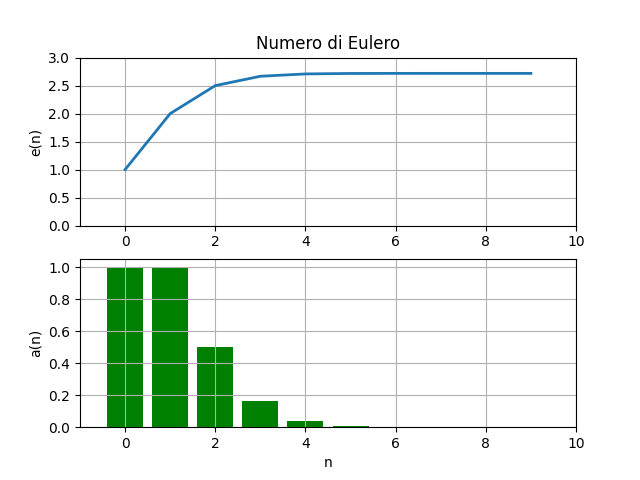Vedi: math.e, math.factorial(), Fattoriale
Serie

import math # math.factorial()
PASSI=10
Sn=0
for n in range(PASSI):
fn = math.factorial(n)
an = 1/fn
Sn += an
print("%i | %6i | %12.10f | %12.10f"%(n, fn, an, Sn))
Output
0 | 1 | 1.0000000000 | 1.0000000000
1 | 1 | 1.0000000000 | 2.0000000000
2 | 2 | 0.5000000000 | 2.5000000000
3 | 6 | 0.1666666667 | 2.6666666667
4 | 24 | 0.0416666667 | 2.7083333333
5 | 120 | 0.0083333333 | 2.7166666667
6 | 720 | 0.0013888889 | 2.7180555556
7 | 5040 | 0.0001984127 | 2.7182539683
8 | 40320 | 0.0000248016 | 2.7182787698
9 | 362880 | 0.0000027557 | 2.7182815256
matpolotlib

import math
import matplotlib.pyplot as plt
PASSI = 10
N = []
AN = []
SN = []
Sn = 0
for n in range(PASSI):
an = 1/math.factorial(n)
Sn += an
print(n, an, Sn)
N.append(n)
AN.append(an)
SN.append(Sn)
plt.subplot(2, 1, 1)
plt.grid()
plt.plot(N, SN, linewidth="2")
plt.title("Numero di Eulero")
plt.xlim(-1, PASSI)
plt.ylim(0, 3)
plt.ylabel("e(n)")
plt.subplot(2, 1, 2)
plt.bar(N, AN, color="green")
plt.grid()
plt.xlabel("n")
plt.xlim(-1, PASSI)
plt.ylabel("a(n)")
plt.show()
fractions
Ottieni una successione di frazioni che converge al numero di Eulero!
import fractions
import math
Sn=0
for n in range(10):
fn = math.factorial(n)
an = fractions.Fraction(1, fn)
Sn += an
print("%d | %6d | %8s | %12s | %.10f" %(n, fn, an, Sn, Sn))
Output
0 | 1 | 1 | 1 | 1.0000000000
1 | 1 | 1 | 2 | 2.0000000000
2 | 2 | 1/2 | 5/2 | 2.5000000000
3 | 6 | 1/6 | 8/3 | 2.6666666667
4 | 24 | 1/24 | 65/24 | 2.7083333333
5 | 120 | 1/120 | 163/60 | 2.7166666667
6 | 720 | 1/720 | 1957/720 | 2.7180555556
7 | 5040 | 1/5040 | 685/252 | 2.7182539683
8 | 40320 | 1/40320 | 109601/40320 | 2.7182787698
9 | 362880 | 1/362880 | 98641/36288 | 2.7182815256